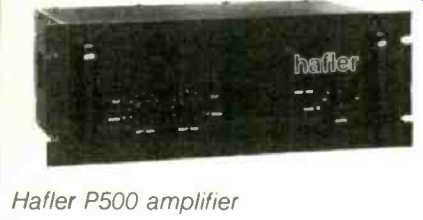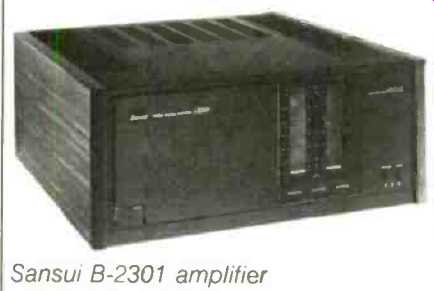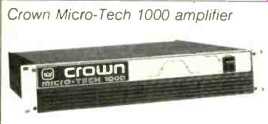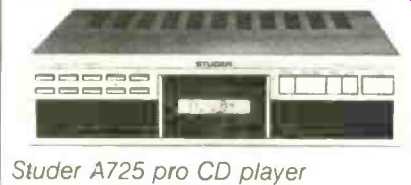ON THE PRO TOUR
As evidenced at last fall's 76th AES Convention in New York, many audio manufacturers are beginning to realize the great sales potential of the burgeoning professional market. David Haller has made an auspicious start in this direction with his new line of professional power amps. These range from the Model P125 (60 watts/channel into 8 ohms, useful in bi- and tri-amplification setups, and costing $350), through the P220 and P225 (rated at 150 watts/channel into 8 ohms and priced at $600 and $510 respectively), to the flagship P500, a brute of an amplifier delivering 250 watts/channel into 8 ohms. The P500 can also be bridged for 800 watts into 8 ohms, and, at $950 each, that's a lot of power for the money. All Hafler pro amplifiers have MOS-FET output transistors, can be hooked up in balanced configuration, feature a number of input connectors (including XLR), and are available in kit form.
Crown has already established their credentials in the professional amplifier market. Their Micro-Tech 1000 is something of a departure, with new circuitry permitting as much as 1,000 watts/channel into 4 ohms in bridged mode, in a relatively small unit measuring 19 x 3 1/2 x 16 inches. In stereo mode, the Micro-Tech 1000's normal output is 250 watts/channel into 8 ohms, with as much as 500 watts/ channel at 2 ohms. Price is $995.

-----Hafler P500 amplifier

-----Sansui B-2301 amplifier
The world of amplifiers is full of acronyms. Perhaps the best known is TIM (transient intermodulation distortion), coined by Matti Otala. Next came IIM (interface intermodulation distortion), also originating with Dr. Otala, and now Sansui has come up with IHM-interface hum modulation. This is said to be the result of interaction between ripple current created by the power supply and counter-electromotive current created by speaker cones in motion. To combat IHM, Sansui has introduced a series of X-Balanced amplifiers; in these units, all circuits are balanced-input, output, power supply, circuit drive, and even the negative feedback.

-----Crown Micro-Tech 1000 amplifier
The internal circuits transfer and amplify signals without reference to the ground potentials. Thus, the X-Balanced amplifiers are claimed to be completely immune to ground-related problems. The top-of-the-line model, the B-2301, offers 300 watts/channel into 8 ohms and has a signal-to-noise ratio of 120 dB. Its slew rate, 400 V/µS, and rise-time, 0.5 µS, are very fast.
As a recording engineer I have long endorsed the use of simple microphone techniques and have variously used three-channel omni spaced array, classic Blumlein, ORTF, M-S, and other similar configurations. These days, most classical digital recording is done on two-channel units-the ubiquitous Sony PCM-F1, Sony PCM1610, JVC 900 series, or Mitsubishi X80. In spite of this, there are occasions when a simple digital mixer would be very helpful. At the AES Convention, Sony gave a paper on such a unit, the K-1105. A number of these mixers have been built and apparently used for mastering of Compact Discs. The K-1105 is an eight-channel mixer with two main and two auxiliary outputs.
There is a signal processing unit, an eight-channel A/D unit, an eight-channel D/A unit, and a remote control. The signal processor has low-cut and high cut filters, plus a four-band equalizer and emphasis/de-emphasis equalizer for each channel. The remote control has faders and pan pots as in an analog mixer. The whole setup is transportable, and, of course, the big advantage is that all mixing and signal processing remain in the digital domain. No availability or price information as yet.
As you can imagine, there was plenty of activity related to Compact Disc players. Studer introduced a $1,550 professional/broadcast player. The Model A725 has balanced high-level line outputs as well as fixed and variable unbalanced outputs, and a host of special cueing functions that studios have requested. For example, it has fader start, for use with mixers which have cueing switches connected to their faders; when you raise the fader, the mixer signals the player to start.

----------Studer A725 pro CD player
Audible cueing lets you scan the disc while listening for your cue point (most CD players are mute in search mode). There's automatic re-cueing, so you can cue up a passage, play it to check your cue point, and return to that point at the touch of a button. (On most player's, cue points disappear from memory once they've been played.) There's also a “ Loop" function-automatic repeat of the music between any two user-marked points.
An LCD panel shows track and index numbers, elapsed and remaining times for the current track, and status of the pause, auto-stop and loop functions. During programming, the display shows the number of steps to be executed and the track numbers or timings of both start and end points. Other features of the Studer Model A725 include a peak-level calibration tone and remote control.
Sony also introduced a professional CD player system, consisting of the CDP-3000 and CDS-3000. This system is a lower-priced version of their big professional player/analyzer, the CDP5000 and CDA-5000. The CDP-3000, at $2,100, is a high-precision, front loading CD player which features an aluminum die-cast chassis and extensive vibration damping for tracking stability. The CDS-3000, at $1,200, is an elaborate control unit, with all the usual displays and features concerning track and timing indications. It affords direct access to any point on a disc within 2 S and has a search dial permitting bidirectional scanning while listening to the reproduced sound. Two CDP-3000 players can be controlled by the CDS3000, and up to eight selections can be programmed in any sequence and intermixed between the two players.

------------Sony D-5 portable CD player

------------Sony D-5 and its accessories
Sony scored another first by introducing a portable CD player. The D-5, which costs $299.95, measures 1 1/2 in. H x 5 in. W x 5 in. D and weighs a mere 1 pound, 5 ounces. Such miniaturization was made possible by incorporating most of the primary digital functions on one high-density VLSI (very large scale integrated) chip and the development of a special semiconductor for the laser pickup, making it less than one-third the size of previous pickups. Six C cells will provide 5 hours of playing time, and an optional rechargeable battery is available. An optional carrying case/battery pack, costing $49.95, permits portable use.
Via a supplied a.c. adaptor, the D-5 can be used as a home CD player or, with the DCC-120 car battery/cigarette lighter type of adaptor, which costs $36.50, in a car.
Despite its diminutive size, the D-5 has the same specifications as full-sized players and many of their features. It can locate a desired selection by rapid forward or backwards scanning and will also permit high-speed scanning, but with the program remaining audible at normal pitch. An LCD shows battery condition, track being played, elapsed time, and number of tracks and time remaining on a disc.
A CD is inserted after pushing the "Open" button on the top corner of the unit, and a special power-off safety switch automatically disengages all mechanisms during loading.
I was under the impression that the D-5 would have to be placed on a level surface in order to play properly. Incredibly, it can be played in any position, even slung over one's shoulder.
Using headphones, you can really have a sort of super Walkman or, as Sony bills it, "Discman."
-------------Components of JVC DS-4000 system
JVC demonstrated the DS-4000 automatic CD player/changer system, which includes an amplifier and has a capacity of 130 discs. (So far, it is only available in Japan.) The main player unit measures 22 7/8 x 18 3/4 x 11 7/8 inches and weighs 60 pounds. It is controlled by a five-digit keypad connected to the player unit by a cable which extends up to 200 feet. The selections are made by pressing the five digit code and then the entry key. JVC figures an average of about 15 selections per Compact Disc; with a 130-disc capacity, this affords a total of 1,950 selections. Each selection on each disc is individually selectable, i.e., tune 6 on disc 12 or tune 3 on disc 110, etc. The numbers of the selected tune, the tune being played, and the next tune are displayed. All "normal" CD specifications apply.
-----------
(Source: Audio magazine, Feb. 1985; Bert Whyte )
= = = =